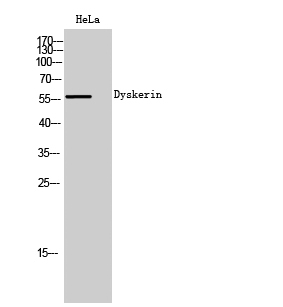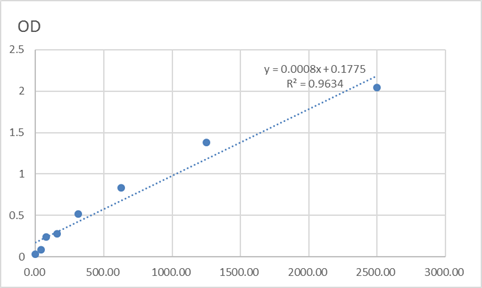Total Dyskerin Cell-Based Colorimetric ELISA Kit
- Catalog No.:KA3480C
- Applications:ELISA
- Reactivity:Human;Mouse;Rat
- Gene Name:
- DKC1
- Human Gene Id:
- 1736
- Human Swiss Prot No:
- O60832
- Mouse Swiss Prot No:
- Q9ESX5
- Rat Swiss Prot No:
- P40615
- Storage Stability:
- 2-8°C/6 months
- Other Name:
- H/ACA ribonucleoprotein complex subunit 4 (EC 5.4.99.-) (CBF5 homolog) (Dyskerin) (Nopp140-associated protein of 57 kDa) (Nucleolar protein NAP57) (Nucleolar protein family A member 4) (snoRNP protein DKC1)
- Detection Method:
- Colorimetric
- Background:
- catalytic activity:RNA uridine = RNA pseudouridine.,disease:Defects in DKC1 are a cause of dyskeratosis congenita X-linked recessive (XDKC) [MIM:305000]. XDKC is a rare, progressive bone marrow failure syndrome characterized by the triad of reticulated skin hyperpigmentation, nail dystrophy, and mucosal leukoplakia. Early mortality is often associated with bone marrow failure, infections, fatal pulmonary complications, or malignancy.,disease:Defects in DKC1 are the cause of Hoyeraal-Hreidarsson syndrome (HHS) [MIM:300240]. HHS is a multisystem disorder affecting males and is characterized by aplastic anemia, immunodeficiency, microcephaly, cerebellar hypoplasia, and growth retardation.,function:Required for ribosome biogenesis and telomere maintenance. Probable catalytic subunit of H/ACA small nucleolar ribonucleoprotein (H/ACA snoRNP) complex, which catalyzes pseudouridylation of rRNA. This involves the isomerization of uridine such that the ribose is subsequently attached to C5, instead of the normal N1. Each rRNA can contain up to 100 pseudouridine ('psi') residues, which may serve to stabilize the conformation of rRNAs. Also required for correct processing or intranuclear trafficking of TERC, the RNA component of the telomerase reverse transcriptase (TERT) holoenzyme.,online information:DKC1 mutation db,similarity:Belongs to the pseudouridine synthase truB family.,similarity:Contains 1 PUA domain.,subcellular location:Also localized to Cajal bodies (coiled bodies).,subunit:Part of the H/ACA small nucleolar ribonucleoprotein (H/ACA snoRNP) complex, which contains NHP2/NOLA2, GAR1/NOLA1, NOP10/NOLA3, and DKC1/NOLA4, which is presumed to be the catalytic subunit. The complex contains a stable core formed by binding of one or two NOP10-DKC1 heterodimers to NHP2; GAR1 subsequently binds to this core via DKC1. The complex binds a box H/ACA small nucleolar RNA (snoRNA), which may target the specific site of modification within the RNA substrate. During assembly, the complex contains NAF1 instead of GAR1/NOLA1. The complex also interacts with TERC, which contains a 3'-terminal domain related to the box H/ACA snoRNAs. Specific interactions with snoRNAs or TERC are mediated by GAR1 and NHP2. Associates with NOLC1/NOPP140. H/ACA snoRNPs interact with the SMN complex, consisting of SMN1 or SMN2, SIP1/GEMIN2, DDX20/GEMIN3, and GEMIN4. This is mediated by interaction between GAR1 and SMN1 or SMN2. The SMN complex may be required for correct assembly of the H/ACA snoRNP complex. Component of the telomerase holoenzyme complex at least composed of TERT, DKC1, WDR79/TCAB1, NOP10, NHP2, GAR1, TEP1, EST1A, POT1 and a telomerase RNA template component (TERC).,tissue specificity:Ubiquitously expressed.,
- Function:
- telomere maintenance, pseudouridine synthesis, DNA metabolic process, DNA replication, RNA-dependent DNA replication, rRNA processing, RNA processing, telomere maintenance via telomerase, cell proliferation, RNA modification, telomere maintenance via telomere lengthening, rRNA metabolic process, ribonucleoprotein complex biogenesis, telomere organization, ncRNA processing, ncRNA metabolic process, ribosome biogenesis, homeostatic process, chromosome organization, anatomical structure homeostasis,
- Subcellular Location:
- [Isoform 1]: Nucleus, nucleolus . Nucleus, Cajal body . Also localized to Cajal bodies (coiled bodies). .; [Isoform 3]: Cytoplasm .
- Expression:
- Ubiquitously expressed.
- June 19-2018
- WESTERN IMMUNOBLOTTING PROTOCOL
- June 19-2018
- IMMUNOHISTOCHEMISTRY-PARAFFIN PROTOCOL
- June 19-2018
- IMMUNOFLUORESCENCE PROTOCOL
- September 08-2020
- FLOW-CYTOMEYRT-PROTOCOL
- May 20-2022
- Cell-Based ELISA│解您多样本WB检测之困扰
- July 13-2018
- CELL-BASED-ELISA-PROTOCOL-FOR-ACETYL-PROTEIN
- July 13-2018
- CELL-BASED-ELISA-PROTOCOL-FOR-PHOSPHO-PROTEIN
- July 13-2018
- Antibody-FAQs



